Other stones
82 Products
-
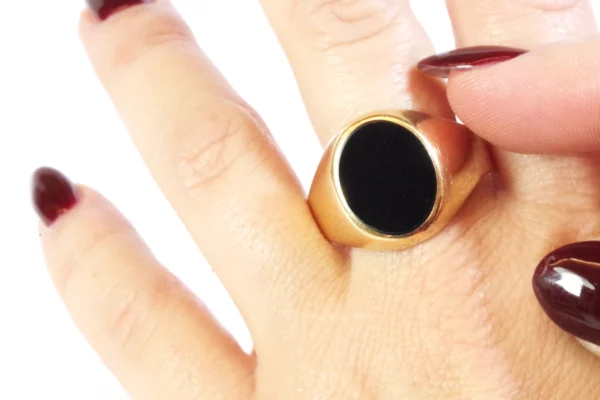
 1260,00€
1260,00€Large signet onyx ring in 18 karat yellow gold (750). Signet ring centered on a smooth oval onyx plaque. Vintage men’s ring, circa 1980, France.
Eagle head hallmark and Lucas silversmith hallmark (active in Saint Ouen in the 1980s)
Finger size: 70 UE or 13 US (small resize possible)
Kitten: 17 x 16 mm
Weight: 8.72 gr
-
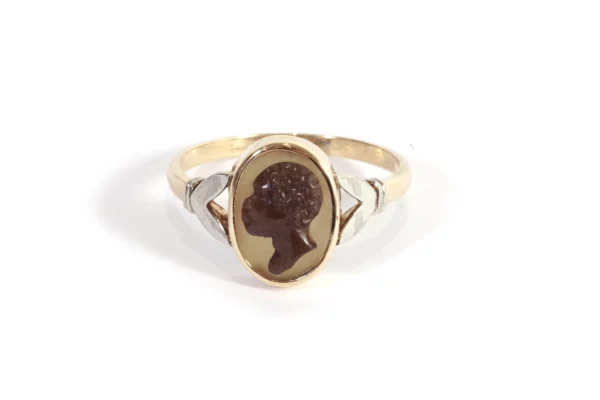
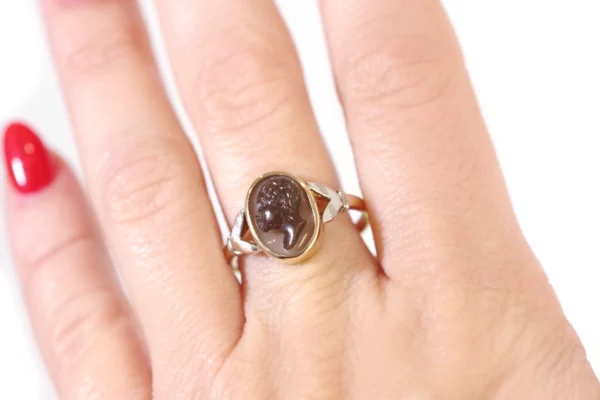 700,00€
700,00€Moor head cameo ring in 18 karat yellow gold. Antique ring set with a two-tone agate cameo carved with a Moor profile. The shoulders of the ring are decorated with stylized leaves. This type of jewelry is called “Blackamoor”, and emerged in the Decorative Arts in Europe, particularly in Venice, during the 19th century. Antique cameo ring, 1900.
Owl hallmark (french state hallmark for 18 karat gold)
Finger size: 57 UE or 7.75 US (can be resized)
Bezel size: 12.5 x 9 mm
Condition: scratches from use
Weight: 2.69 gr
-
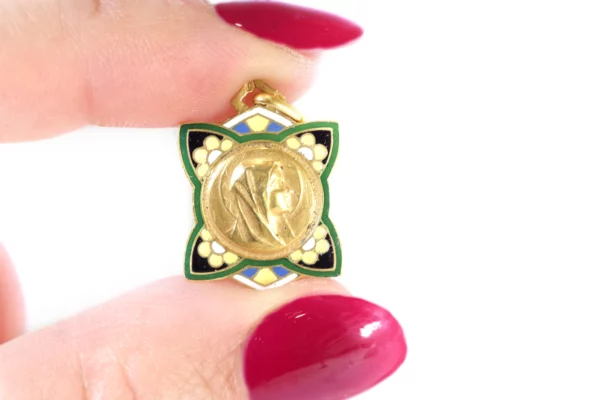
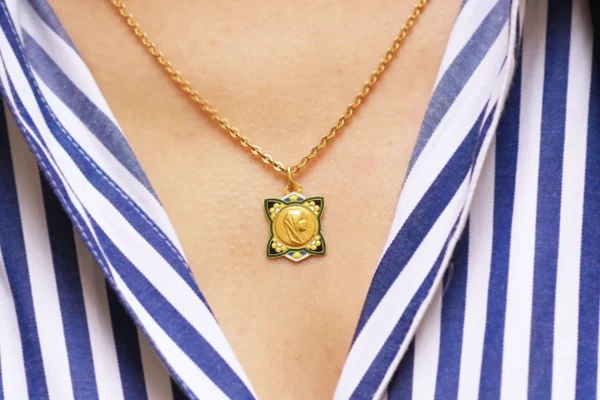 550,00€
550,00€Art Nouveau Virgin Mary medal in 18 karat yellow gold. Antique medal with the profile of the Virgin Mary, in a polychrome enameled frame, decorated with flowers on the four corners. Art Nouveau religious medal, circa 1900, France.
Eagle head hallmark (french state hallmark for 18 karat gold), goldsmith’s hallmark illegible.
Height (including setting): 2.2 cm
Width: 2 cmCondition : Slight scratches from use, the medal is not engraved and can be engraved on request.
Weight : 1.58 gr
*The antique gold chain is not sold with the jewel*
See our antique chains -
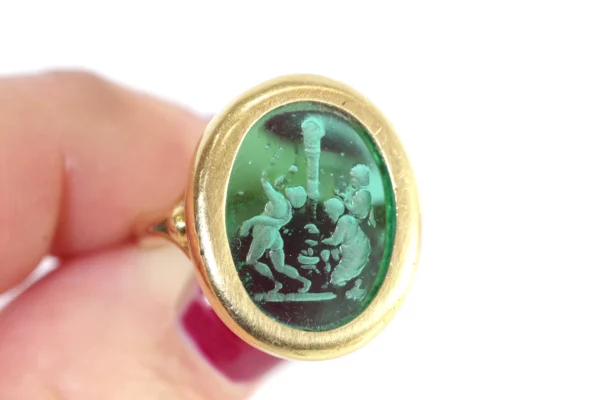
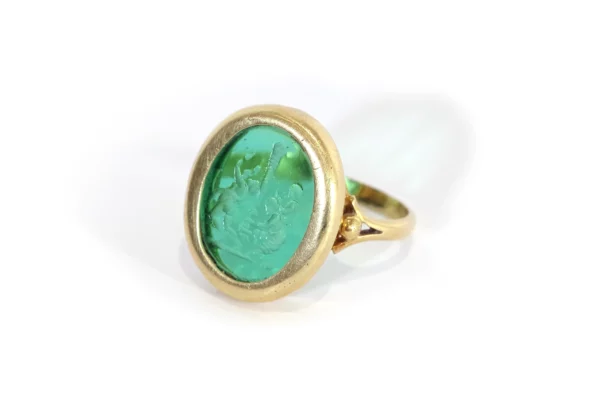 1600,00€
1600,00€Antique green intaglio ring in 18 karat yellow gold. The ring is centered on a 19th-century intaglio on green glass, depicting three figures, musicians and dancers, around a pole. The intaglio is in a closed setting. Two gold balls decorate the shoulders of the ring. Antique intaglio ring, circa 1870.
Owl hallmark, eagle head hallmark (french state hallmark for 18 karat gold)
Finger circumference: 55 UE or 6.75 US (can be changed)
Bezel size: 19 x 16 mm
Condition: scratches from use
Weight : 5.31 gr
*The antique box is not sold with the jewel*
-
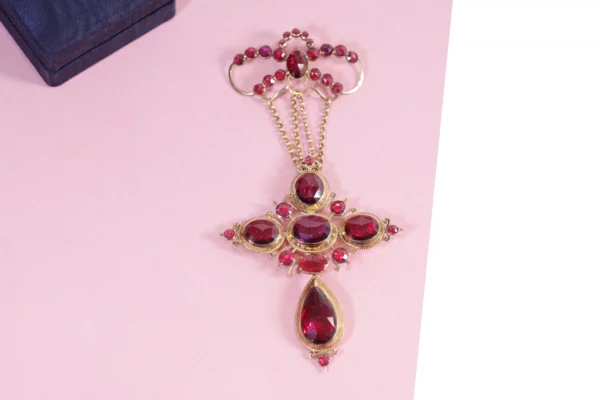
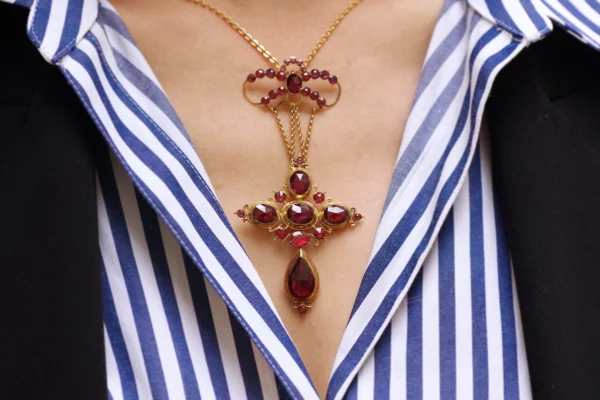 2200,00€
2200,00€Badine Perpignan garnet cross in 18 karat rose gold. Antique pendant in the form of a cross with two elements: a knot at the top and a large cross at the bottom. The two elements are linked by four fine chains. The lower part of the cross is mobile. The entire piece is set with 33 garnets on red foils, cut in round, oval and drop shapes. This is a typical piece of jewelry from the Perpignan region. The term “badine” indicates that the lower part of the cross is mobile. French regional antique jewelry, Languedoc Roussillon, Perpignan, early 20th century.
Owl hallmarks (french state hallmark for 18 karat gold)
Dimensions: 10 x 5 cm
Size of largest garnet: 15 x 10 mmCondition: small dents, scratches and oxidation
Weight: 11.45 gr
Further information: These jewels were often worn on a velvet or silk ribbon, as in the “Portrait de Clara Salamo à la croix badine”, Paris, 1880, painted by A.Legras (see photo)
*The antique gold chain is not sold with the jewel*
See our antique chains -

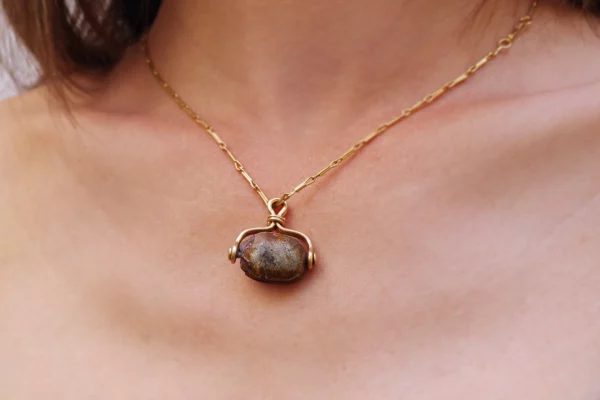 960,00€
960,00€Egyptian scarab pendant in 14 karat rose gold. Pendant featuring a steatite scarab mounted on a pivot, the reverse engraved with a lion walking to the right, tail over back. The lion already appears on early Middle Kingdom scarabs, but is particularly popular during the Second Intermediate Period and the New Kingdom. Pendant dating from the 13th to 15th dynasties, 1650-1550 B.C.; late 19th century gold mount.
Shell hallmark (french state hallmark for 14 karats)
Height: 26 mm
Width: 26 mmCondition: wears and lacks on the stone
Weight : 7.78 gr
*The antique gold chain is not sold with the jewel*
See our antique chains -
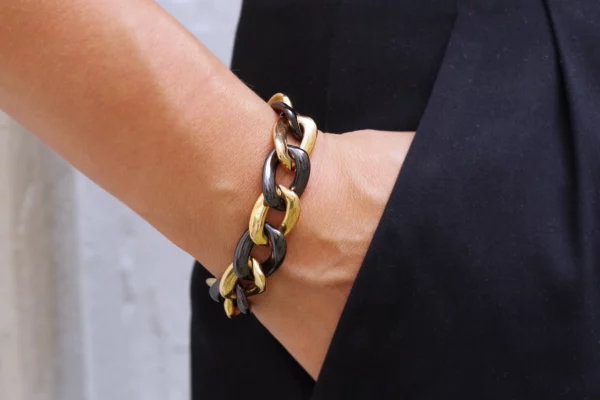
 3400,00€
3400,00€Large vintage hematite bracelet in 18 karat (750) gold bracelet. Bracelet with large links of yellow gold and hematite, creating a beautiful contrast between the color of the two materials. The clasp is concealed in an invisible gold ring. Second-hand bracelet, circa 1980.
Mark 750 and oval goldsmith’s hallmark, owl and eagle hallmarks
Length: 18.5 cm
Width: 15 mmNote: the bracelet has a chain and 8 safety pins.
Condition: fine wear scratchesWeight: 39 g
More information : Hematite is a stone that takes its name from the Greek haimatos, meaning “blood”. It is a black stone with a metallic sheen that leaves a red trace when rubbed on porcelain. In ancient times, Egyptians, Greeks and Romans used it for amulets, intaglios and jewelry.
-
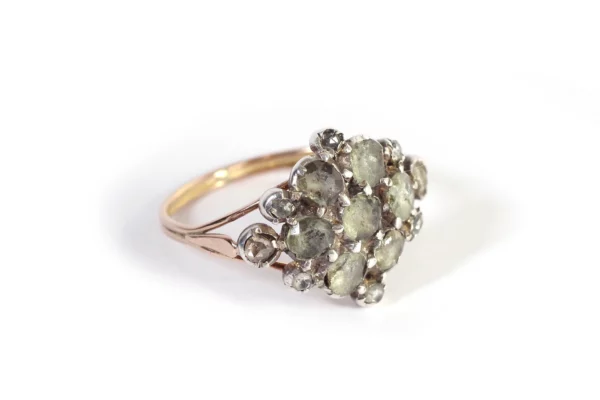
 900,00€
900,00€Antique 19th century ring in 18 karat rose gold and silver. Lozenge-shaped ring set with diamonds and rose-cut natural stones (topazes or chrysoberyls) on foils. The ring is soberly decorated with two strands of gold, adorned with a stylized leaf at shoulder level. The stones are quite worn, making it difficult to determine their nature. Early 19th century ring, probably Dutch.
Owl and swan hallmarks.
Finger circumference: 55 EU or 7 US (can be resized)
Bezel size: 15 x 19 mmCondition: chips and scratches, old setting
Weight : 3.12 gr
-
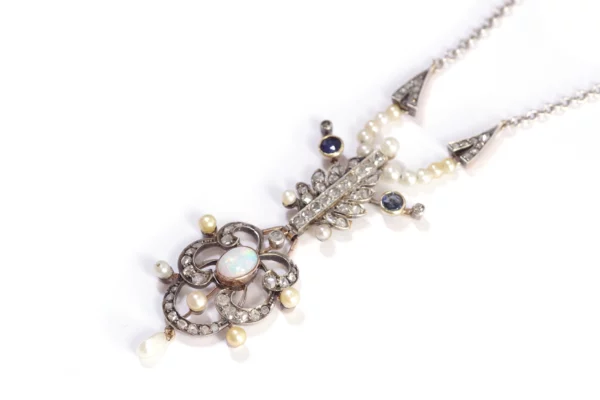
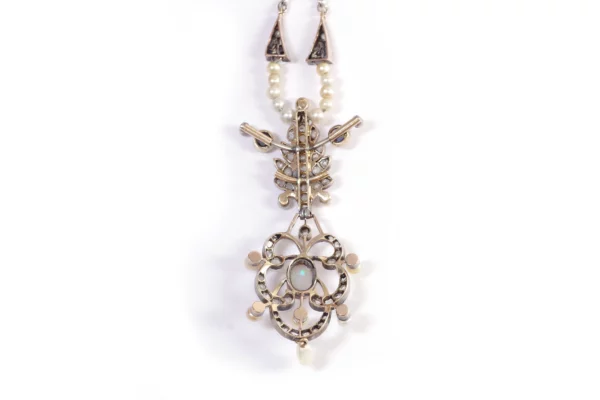 1100,00€
1100,00€Opal diamond pendant necklace in 9 karat gold and silver. Antique pendant composed of various floral elements set with 65 rose-cut diamonds, fine pearls and sapphires. An opal cabochon adorns the lower part of the pendant. Two natural round sapphires adorn the upper part of the jewel. Silver chain and round clasp. Belle Époque necklace, circa 1895.
Clover and swan hallmarks
Chain length: 50 cm
Height: 75 mm
Width: 24 mmEstimated sapphire weight: 0.18 carat
Estimated opal weight : 0.67 carat
Estimated diamond weight : 0.30 caratCondition: scratches from use
Weight : 12.18 gr
-
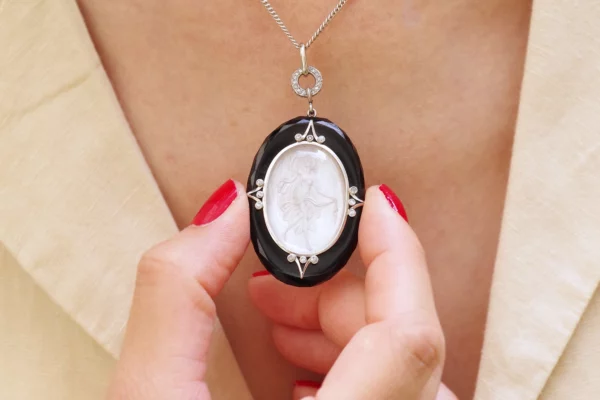
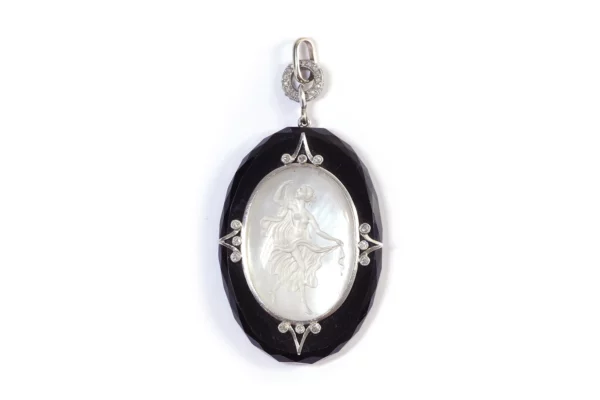 1200,00€
1200,00€Art Deco onyx diamond pendant in platinum (950). An oval pendant from the Art Deco period, with a faceted onyx mounting and a mother-of-pearl plate under a rock crystal. The rock crystal is decorated with an intaglio depicting a dance allegory. : a nude woman dancing and playing with a veil. This central motif is set in a platinum surround and decorated with scrolls set with twelve rose-cut diamonds. The bezel is adorned with a ring entirely set with diamonds (on both sides). Antique pendant, circa 1930, France.
Dog head hallmark (french state hallmark for 18 karat gold)
Height (with clasp): 59 mm
Width: 29 mmCondition: slight wear scratches, the back part may have been closed with another glass.
Weight : 13.02 gr
*The antique gold chain is not sold with the jewel*
See our antique chains -
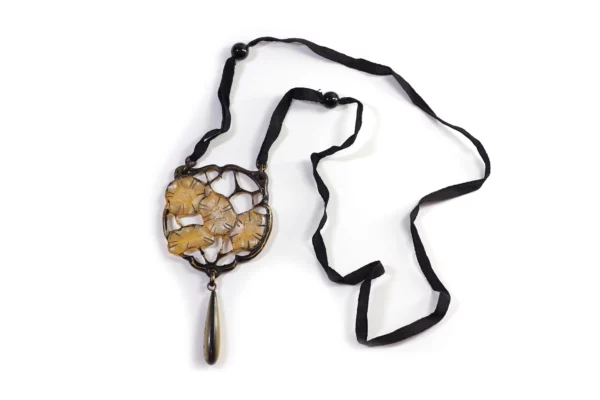
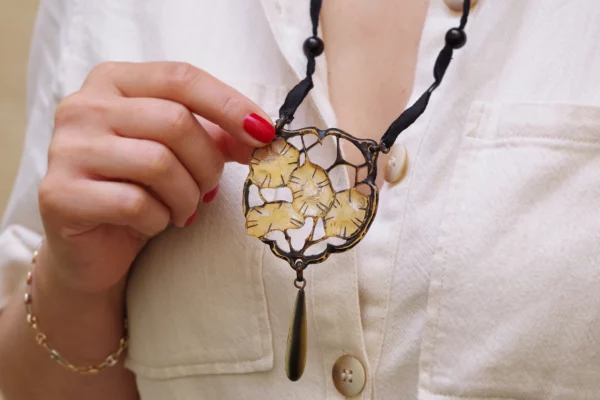 1500,00€
1500,00€George Pierre Art Nouveau necklace in horn. Long Art Nouveau necklace in carved blond horn, embellished with black and ochre inks, in the shape of annual honesty plant. The pendant holds a blond horn tassel also colored black and ochre. The necklace is made of black silk ribbon decorated with two black glass beads. Art Nouveau necklace by Georges Pierre dit “GIP”, circa 1910, France.
Signed on the reverse GIP for Georges Pierre
Length: 72 cm
Design dimensions: 16 x 59 mmCondition: paint missing, scratches from use
Weight : 14.75 gr
More details : Slices of horn were dipped in hydrogen peroxide to make them translucent, then bathed in chemicals to give a shimmering sheen to the wings or a rosy sheen to the petals. The pendants, sculpted and dyed with inks, were mounted on silk ribbons, cords or chains with pastel glass beads repeating the delicate hues. Elisabeth Bonté and Georges Pierre G.I.P., initially rivals, pooled their resources and talents before producing horn jewelry until 1936, when Bakelite became the preferred material for costume jewelry.
-
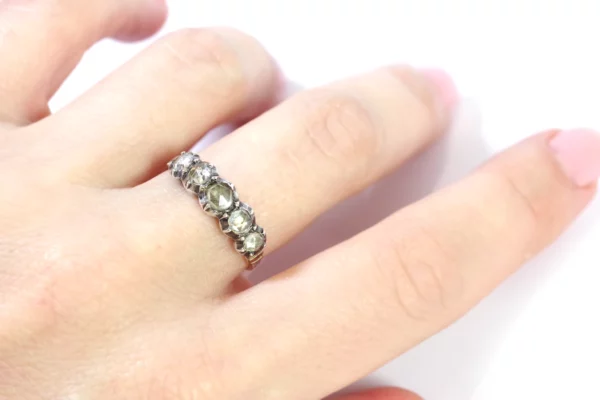
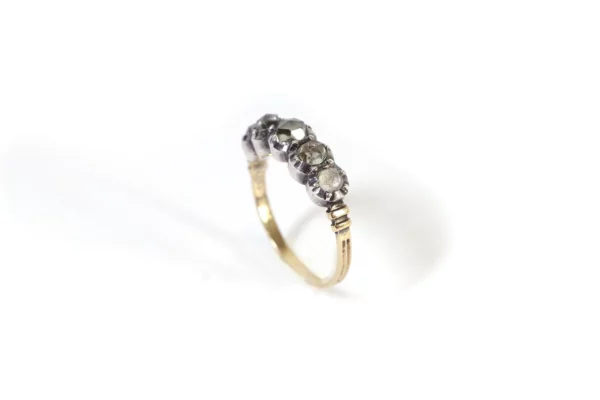 600,00€
600,00€Victorian paste ring in 18 karat yellow gold and silver. Antique ring set with a line of five faceted white paste stones iimitating diamond. Antique engagement ring, circa 1850, France.
Eagle head hallmark (french state hallmark for 18 karat gold) and partially erased goldsmith’s hallmark.
Finger size: 50.5 EU or 5.5 US (resize possible)
Width: 5.5 mm
Condition: scratches from use
Weight : 2.58 gr
